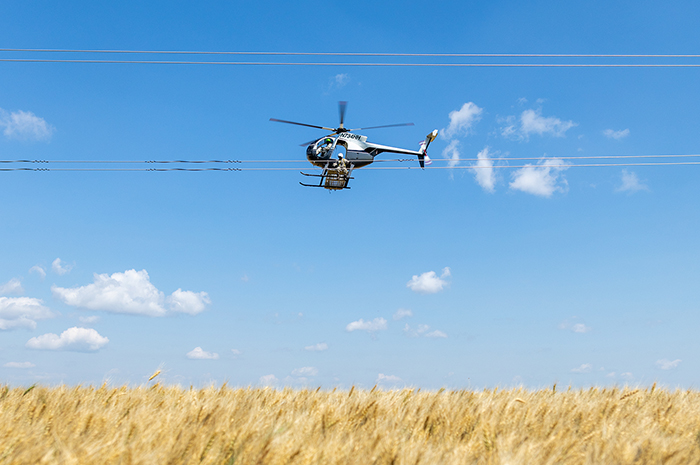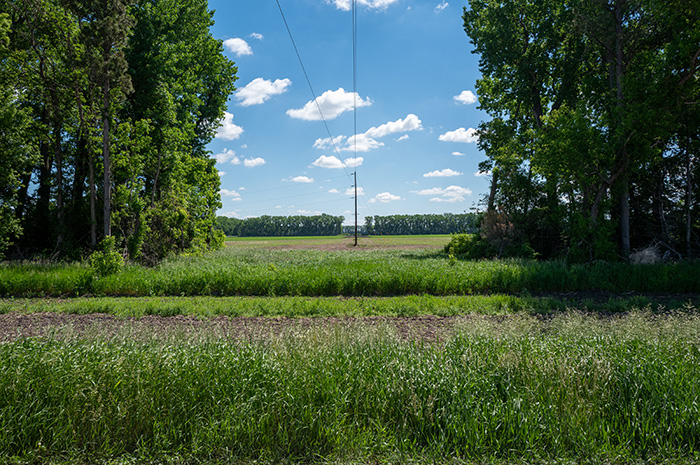The wrath of the Red
Twenty-five years after the historic 1997 ice storm and flood, current Minnkota employees reflected on the natural disasters that tested the resilience of the cooperative.
Cameron Korynta remembers driving north to Grand Forks 25 years ago and seeing a wall of water moving toward the city.
“There was 100 miles of water coming right at us,” said Korynta, who was working as an electrician at the time. “I remember thinking Grand Forks isn’t going to make it through this.”
The spring of 1997 was a blur for Minnkota employees as they faced two of the worst natural disasters in the cooperative’s history over the span of a month. While some of the details are hard to recollect, there are memories that remain crystal clear to this day.

It started with a severe ice storm and blizzard that swept through the Red River Valley on April 5-6, snapping power poles like toothpicks and wiping out a significant portion of Minnkota’s power delivery system. Harold Narlock was part of a crew called out to Argyle, Minn., to work on a substation as the storm arrived. Work stopped as wind, ice and snow decimated most everything in its path.
“We heard pole after pole snapping behind us, but we couldn’t see a thing because it was pitch-black outside,” said Narlock, who worked as an electrician at the time. Somehow his crew made it to a co-worker’s home in nearby Warren, Minn., where they were stranded for the next two days.

When the storm subsided, Minnkota’s system was left in shambles. About 540 poles on Minnkota’s 69-kilovolt (kV) system and 101 aluminum structures on its 345-kV line running from Center, N.D., to Fargo were completely destroyed. Minnkota crews worked closely with the member cooperatives and other utilities to remove debris and begin the rebuild.
“The damage was so widespread,” lineworker Ron Hanson said. “Usually, an ice storm hits little pockets here and there. This was everywhere.”
Minnkota employees worked long hours throughout the next week to restore service to 70 of 193 substations that were out of service, bringing power back to 50,000 member-consumers. While power delivery crews were out in treacherous conditions, office staff took on an unfamiliar role of framing crossarms for power poles and getting material ready for crews.
“Everyone was helping, and it was never-ending,” Korynta said. “Even the farmers were out with us pulling trucks out of the mud and getting us to where we needed to be.”

Water everywhere
With the one disaster barely contained, another soon followed. Just two weeks later, the raging waters of the Red River of the North inundated the Greater Grand Forks area, forcing 50,000 people to flee their homes – including most of Minnkota’s Grand Forks-based employees. The scene turned apocalyptic as several downtown buildings became engulfed in flames.
“I remember being reassured that we were safe and the next minute being told we had to evacuate because the dike on our end of town had broken,” said Lisa Severson, who worked in Accounting at the time. “I remember loading up the kids and thinking, where will we go? All the bridges were closed, how are we going to get out of town? Do we leave our electricity on or turn it off? It was dark, there was water everywhere and we were all scared.”

Minnkota had built a series of dikes around its facilities and even piled dirt inside the building around its Control Center. Unfortunately, none were equipped to handle the rising Red River. Muddy waters swept through Minnkota’s headquarters, including the warehouse, diesel plant and main office building.
With no power in town, Joe Leddige remembers the darkness that covered the region.
“It was pretty eerie driving in at night and not being able to see a thing,” the 45-year Minnkota employee said.

Navigating challenges
In 1997, the Internet was not widely used and cellphones were still a rarity for most people. Minnkota invested significant time and resources into keeping its microwave radio system up and running. Portable generators were placed at communication towers throughout the system so crews could keep in contact through vehicle radios.
“It was 15-hour days going around gassing up these generators,” said electrician Dean Swatlowski. “Every day was a blur. You just did what you had to do.”
With floodwaters ravaging much of Grand Forks and the surrounding areas, driving became much more difficult. Minnkota utilized a helicopter to maneuver employees throughout the system and to their temporary work areas at Nodak Electric Cooperative or on the second floor of the headquarters building.
With Leddige’s home on higher ground outside of town, he hosted numerous employees – including a group from the Milton R. Young Station near Bismarck who traveled to Grand Forks with trucks, tools and pumps to remove water from buildings and make repairs.
“I ended up running a bed and breakfast,” Leddige said. “I was up at 5 o’clock in the morning to feed the guys. A helicopter would come to pick them up and drop off guys who’d been working all night and were hungry.”

Road to recovery
When the floodwaters receded, the restoration work continued at Minnkota’s facilities. Employees cut up and removed soaked carpeting, manned pumps and trudged through muck-filled buildings in the massive cleanup effort.
While employees worked long days to bring power back to communities and repair Minnkota’s headquarters, many dealt with home damage and managing family members who temporarily relocated outside of town. Others lost everything.
“We would work all day and spend the evenings trying to get all the wet stuff out of our basement and try to salvage what we could from the mess,” Severson said.

Following the flood, Grand Forks acted quickly to build a massive levee system at a cost of $409 million. To make room for the levees, entire neighborhoods were demolished. The river is now surrounded by a Greenway recreation area and a thriving downtown. Rising river waters no longer create the panic they once did.
Although things looked bleak 25 years ago, the recovery doesn’t surprise Leddige.
“We’re North Dakota tough,” he said with a smile.
MAIN IMAGE: Efforts to save Service Centers 1 and 2 with a secondary dike continued here two days before the flood's crest. (Photo by Jean Walton, NDAREC)
...



